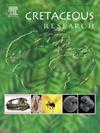辽西建昌盆地冰沟组下白垩统孢粉植物及其锆石年龄
IF 1.7
3区 地球科学
Q1 GEOLOGY
引用次数: 0
摘要
辽西建昌盆地是中国重要的中生代非海相沉积盆地之一。该盆地下白垩统冰沟组出露良好,煤、化石资源丰富。近年来对该地层的无脊椎动物和植物化石的研究表明,该生物群与著名的阜新生物群相对应。本研究发现了一个由59属153种组成的孢粉植物群,以Cicatricosisporites-Osmundacidites-Concentrisporites组合为代表。该组合以裸子植物花粉为主,其组成特征以及Cicatricosisporites、Appendicisporites、Erlianpollis和Jiaohepollis等年代诊断元素的出现证明了其在上-下白垩统的存在。在该组煤层中部进行了新的U-Pb锆石定年,其年龄为106.5±1.9 Ma,首次确认了冰沟组和孢粉植物属下白垩统阿尔比系。利用孢粉生态群(SEG)模型和植物生态模型(Eco-plant model)重建了孢粉区系的古生态环境特征。这表明,植物群在一个以高地和低地河流系统共存为特征的环境中繁盛。在这种植物群存在的时期,湿度水平略有增加,环境保持稳定,没有显示出大规模气候扰动的证据。本文章由计算机程序翻译,如有差异,请以英文原文为准。
Lower Cretaceous palynoflora from the Binggou Formation of Jianchang Basin, western Liaoning, NE China and its U–Pb zircon age
The Jianchang Basin of western Liaoning, NE China is one of the important Mesozoic non-marine sedimentary basins in China. The Lower Cretaceous Binggou Formation is well exposed in this basin yielding abundant coal and fossils. Lately research on the invertebrate and plant fossils from this formation indicates this biota chronologically corresponding to the famous Fuxin biota. The present work uncovers a palynoflora in the Formation composed of 153 species of 59 genera which are represented by the assemblage of Cicatricosisporites-Osmundacidites-Concentrisporites. The assemblage is dominated by gymnospermous pollen and is evidenced of the upper Lower Cretaceous by the characters of its composition and the occurrence of such age-diagnostic elements as Cicatricosisporites, Appendicisporites, Erlianpollis and Jiaohepollis. New U–Pb zircon dating made by the authors from the middle of the coal seam of the formation, indicates a 106.5 ± 1.9 Ma age, and confirms the Binggou Formation and palynoflora belonging to the Albian of the Lower Cretaceous, for the first time. The paleoecological and paleoenvironmental characteristics based on the palynoflora are also reconstructed by using the Sporopollen EcoGroup (SEG) model and the Plant Ecological Model (Eco-plant model). It suggests that the flora flourished in an environment characterized by the coexistence of both highland and lowland river systems. During the period when this flora existed, humidity levels increased slightly, and the environment remained stable, showing no evidence of large-scale climatic disturbances.
求助全文
通过发布文献求助,成功后即可免费获取论文全文。
去求助
来源期刊

Cretaceous Research
地学-地质学
CiteScore
4.10
自引率
19.00%
发文量
235
审稿时长
12 weeks
期刊介绍:
Cretaceous Research provides a forum for the rapid publication of research on all aspects of the Cretaceous Period, including its boundaries with the Jurassic and Palaeogene. Authoritative papers reporting detailed investigations of Cretaceous stratigraphy and palaeontology, studies of regional geology, and reviews of recently published books are complemented by short communications of significant new findings.
Papers submitted to Cretaceous Research should place the research in a broad context, with emphasis placed towards our better understanding of the Cretaceous, that are therefore of interest to the diverse, international readership of the journal. Full length papers that focus solely on a local theme or area will not be accepted for publication; authors of short communications are encouraged to discuss how their findings are of relevance to the Cretaceous on a broad scale.
Research Areas include:
• Regional geology
• Stratigraphy and palaeontology
• Palaeobiology
• Palaeobiogeography
• Palaeoceanography
• Palaeoclimatology
• Evolutionary Palaeoecology
• Geochronology
• Global events.
 求助内容:
求助内容: 应助结果提醒方式:
应助结果提醒方式:


